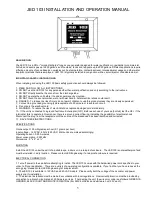
3
2. SAFETY INSTRUCTION
2.1
POSITIONING
2.1.1 Do not put the Inverter on a rugged or inclined surface.
2.1.2
Do not install the Inverter near water or in damp environments.
2.1.3 Do not install the Inverter where it would be exposed to direct sunlight.
2.1.4 Keep the Inverter far away from heat emitting sources.
2.1.5 Do not block ventilation openings in the inverter housing.
2.1.6 Do not leave objects on top of the Inverter.
2.1.7 Do not expose the Inverter to corrosive gasses.
2.1.8 Ambient temperature: 0°C – 40°C.
2.2
INSTALLATION
MOUNT THE SINGLE HANGING BRACKET ONTO THE WALL.
SLIDE THE INVERTER OVER THE BRACKET SO THE INVERTER HANGS FROM THE
BRACKET.
2.2.1 Connect the Inverter AC OUTPUT only to an earthed DB Panel.
2.2.2 The AC connections are located at the top of the inverter under the top side cover.
(Where the Live and Neutral IN, Live and Neutral OUT and Earth Connections are.)
2.2.3 If a 220vAC supply or a generator is available, connect into the Live and Neutral IN
Connection.
2.2.4 Make sure the BATTERY INPUT CIRCUIT BREAKER is OFF.
2.2.5 Place cables in such a way that no one can step on or trip over them.
2.2.6 Battery cables must be a minimum of 35mm² and as short as possible.
2.2.7 The battery cables come out at the bottom of the inverter, next to the BATTERY
INPUT CIRCUIT BREAKER.
2.2.8 The unit must be mounted in a vertical position against the wall.
2.2.9 Minimum battery bank of 300A/Hours is suggested.
2.3
EARTHING OF EQUIPMENT
Equipment surge protection products are an effective way of controlling dangerous surges that
can enter a facility. When strategically placed and correctly installed, the Surge Protectors will
effectively reduce harmful over voltage conditions that can damage electrical and electronic
equipment.
It is important that the protection system includes both structural and surge protection equipment.
When lightning current passes into the ground through any conductor (Example: Tree Trunk) a
powerful electromagnetic force is set up due to the fast rise times of the strike. This
electromagnetic force then couples into any inductive loops that may be available in nearby
buildings. When these currents equalize, damage usually occurs to the equipment.





































